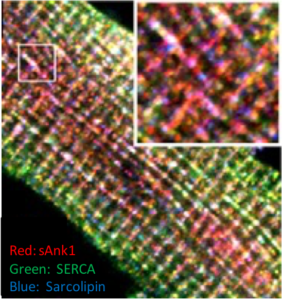RESEARCH PROGRAM IN THE BLOCH LABORATORY
Architecture of Striated Muscle
General Summary
Excitable cells receive and process electrical signals by using highly specialized structures in their intracellular and plasma membranes, including pre- and postsynaptic membranes, and intracellular membrane compartments that are themselves excitable or that sequester and release Ca2+. We have been trying to learn how these structures form and what determines their locations within cells. We have also been asking how they are stabilized as the cell changes shape with activity or growth, and how mutations that affect these structures alter cellular functions and the overall health of the organism.
We have been studying these and related questions in striated muscle cells, a class of excitable cells that are almost paracrystalline in their organization and that do something that most other excitable cells are unable to do – contract. We have focused on the membranes of fast twitch skeletal muscle and the structures that support them, to learn how their membrane compartments become organized and remain stable under the stresses and strains exerted during contraction.
Understanding these phenomena is essential to understanding how healthy muscle works, how it responds to injury, and how it is affected by mutations that cause muscular dystrophy.
Scientific Interests
A major focus of these studies is on the cytoskeleton and how it interacts with the different membrane systems in skeletal myofibers. In a few of our projects, we focus more specifically on how these factors are altered in particular muscular dystrophies or myopathies, and how we might correct these changes by developing treatments for these diseases.
We have studied several sets of structural proteins, some of which organize membranes in other cell types, but whose roles in skeletal muscle have not yet been fully elucidated. In particular, we have been studying the spectrin, ankyrin and titin and obscurin superfamilies, the superfamily of intermediate filament proteins, and microtubules. Earlier studies focused on the contribution of cytoskeletal proteins to the organization of the postsynaptic membrane of skeletal muscle, rich in acetylcholine receptors. More recent studies have examined the organization of the integral and peripheral membrane proteins of other membrane compartments of muscle fibers. Ongoing research addresses how structural proteins influence the organization of the sarcolemma (the plasma membrane and closely associated structures of striated muscle), intracellular membranes and myoplasm; and how changes in these proteins are linked to injury and repair or disease, including muscular dystrophy. Newer projects focus on methods of growing human muscle tissue to maturity in mice (xenografting) and on mu-crystallin, a cytoplasmic protein that regulates muscle metabolism by binding thyroid hormone.
